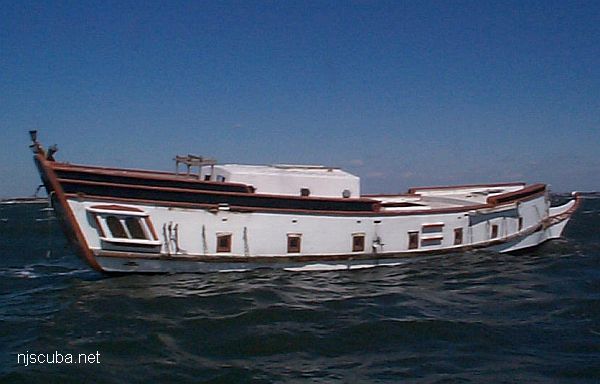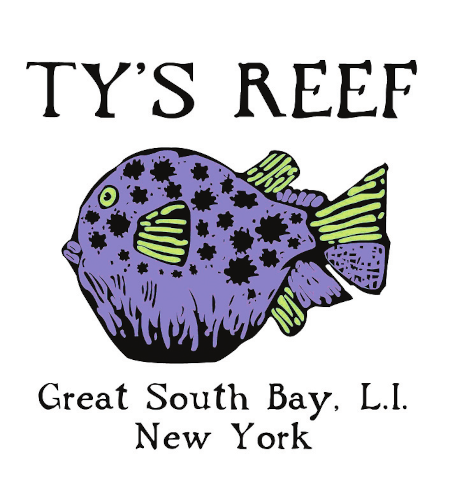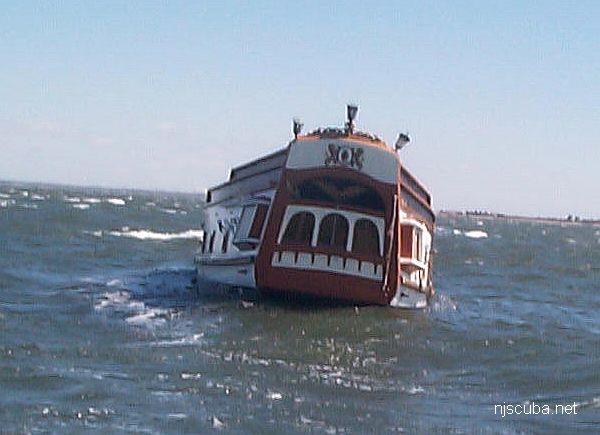Peregrine

- Type:
- artificial reef, houseboat, replica Spanish galleon
- Specs:
- ( 48 ft ) wood hull
- Sunk:
- 2002 - Yellowbar Artificial Reef
- Depth:
- 21 ft
- GPS:
- 40°38.030' -73°14.571'
The Story Behind Ty'S Reef
By Fred Golofaro
TheFisherman.com
October 25, 2012

I was asked what the Ty's Reef decal on my car window was about by another
fisherman at Democrat Point one evening last week. The reef, part of The Fisherman Reef in Great South Bay, is the legacy of a local resident, Ty Hellreigel, who died too young in a tragic boating accident on the bay he loved. His story, and that of the reef in his name, follows.
Ty Hellriegel was born and raised in Bay Shore, Long Island. His love for the sea, mirrored in his brilliant blue eyes, began as a young child. He caught his first big shark at age five and refinished his first little outboard dinghy when he was only eight. He spent much of his free time as a child waterskiing, clamming, drawing and writing about the sea. As he grew, so did the size of his boats. He moved from dinghies, to whalers, to speedboats and finally to the Peregrine over which you will fish today. He graduated from art school and began making a living as a commercial artist.
In 1989, Ty discovered the Peregrine abandoned in a Florida boat yard. The Peregrine was a 60-foot replica of a two-masted 16th century Pirate Ship with two masts stretching 55 feet into the sky. It had rows of windows high on its stern and made Ty think of the courageous Vikings he admired. Ty fell in love and knew that he had found his home. Ty settled the yard bill of the previous owner and sailed the Peregrine north to Orawoc Creek in Islip. The Peregrine became his art studio and home for the rest of his life. Ty had always been a free spirit, dreaming that one day he would sail the Peregrine back south to Key West and spend his days painting and selling his art at sunset on Duval Street.
On a stormy night, September 21, 2001, Ty hopped aboard his friend's boat and headed to Fire Island as he so often did. That night, Ty drowned in a terrible boating accident. He was only 35 years old. His family toiled with the urgent question, "What to do with the Peregrine?" They knew they couldn't sell her. Ty and the Peregrine were as inseparable as mast and sail. They decided that the best memorial to him would be to sink his beloved Peregrine and make it part of a permanent fishing reef in the Great South Bay that he loved. His spirit, his home and art studio could somehow keep living on in these waters that were so much a part of his life.
The official sinking of the boat was approved by the Department of Conservation and the United States Coast Guard thanks to Fred Golofaro and The Fisherman Magazine. The boat was stripped of its masts and gutted in preparation. Ty's family snuck aboard a few mementos they felt ought to go down with the boat: Ty's crazy purple combat boots, which they nailed to the wooden floors, and a snapshot of Binky, his favorite cat. On May 3, the Peregrine was towed out to The Fisherman Reef just southwest of the WR buoy along South Beach, Fire Island battling high winds with gusts over 35 mph.
Upon arrival, it was filled with concrete, drilled with holes and filled with water. As Ty's family and friends looked on from a flotilla of private boats, the Peregrine slowly returned to the sea. The reef that has grown around the Peregrine, Ty's Reef, was born and has become a living source of beauty and refuge for all who venture upon it.
Ty was a special guy. People were drawn to Ty because of his kindness. He found joy in the simpler things in life and had a wild smile that was contagious. The avid sailor and fisherman - a man who was often referred to as the Ernest Hemingway of Long Island - left behind a legacy of friendship and passion for life that was skillfully expressed in his poetry and artwork.
The Ty Hellriegel Peregrine Foundation (www.tysreef.org) regularly takes youth fishing over Ty's Reef, because we know he'd want other kids to share the joy of the sea that captured his heart. We hope that as these youngsters fish over the Peregrine that they will feel his spirit and enjoy the sea breeze, sea gulls, and spectacular vistas that inspired his art and his life. His crystal blue eyes always shined so brightly. We hope they will feel that light as the sun dances off the waves.




Questions or Inquiries?
Just want to say Hello? Sign the .